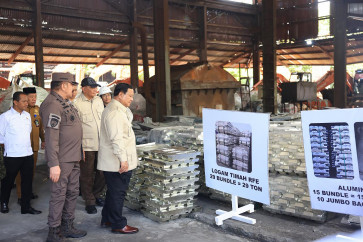Popular Reads
Top Results
Can't find what you're looking for?
View all search resultsPopular Reads
Top Results
Can't find what you're looking for?
View all search resultsSome opt to stick to their old ways, despite changing times
Abdul Wadot Syahroni, 41, concentrates as he paints the metal grid on top of a kerosene stove
Change text size
Gift Premium Articles
to Anyone
A
bdul Wadot Syahroni, 41, concentrates as he paints the metal grid on top of a kerosene stove.
"The grid is important because it supports the pots and pans when they are over the flame part," he said, while standing in his workshop located under a bridge at the Cawang intersection, East Jakarta.
"We wouldn't want our customers to get covered in hot oil because the pan had tipped," he added, smiling.
Abdul has a reason to be happy.
He received 30 kerosene-stove orders during the Idul Fitri holiday after experiencing a drastic drop in sales in the last two years.
In 2007, the government launched a program to reduce household consumption of kerosene and replace it with liquefied petroleum gas (LPG).
"Before the government launched its program, I used to make hundreds of these because I'd be getting orders every day. Now I am lucky if I sell four or five of these kerosene stoves a month," he said.
Abdul is one of many Jakarta residents who has decided to continue running a business widely considered outdated.
He sells 16-fuse kerosene stoves for Rp 60,000 (US$6.18), 20-fuse ones for Rp 80,000 and 40-fuse ones for Rp 150,000.
Abdul is the only stove vendor near the Cawan intersection still making kerosene stoves. Other vendors converted to making and selling gas stoves.
The government's kerosene conversion program has been considered a success as more than 5.3 million households across the country stopped using kerosene this year, state oil and gas company Pertamina says.
Pertamina said the program had saved the company Rp 5.32 trillion in fuel subsidies between 2007 and 2008.
But such "successes" are irrelevant to Abdul.
He said he had continued making kerosene stoves because he wanted to preserve the skill and art that had been passed down from his father's father.
Abdul realizes that his skill may no longer be required one day, which is why he has expanded his services to repairing gas stoves or other kitchen appliances, though he refuses to go into the gas-stove business.
"I can do other stuff and I get by. But I've been making kerosene stoves for over 30 years. It just doesn't feel right for me to stop," he said.
Another example of a vendor sticking to a seemingly outdated trade is 25-year-old Ananda, who sells Lou Han fish, otherwise known as flowerhorn, at the Radio Dalam Market, South Jakarta.
Lou Han fish, which were the craze in 2002, used to sell for millions of rupiah at the market.
However, the Lou Han fish market bubble popped in 2003.
The price of the fish plunged after vendors began breeding them en masse.
But as most fish vendors return to selling goldfish and arowanas -also called bonytongues, Ananda stuck with the Lou Han.
"Beautiful ain't it. Many people ask about it too," he said, showing off a 40-centimeter Lou Han fish swimming alone in one of his aquariums.
Ananda said he began breeding Lou Han fish at the Barito Market in South Jakarta in 2002, just as the fish started to become popular.
He followed the craze until 2003, and stuck with it after demand dropped.
Last year, the city administration evicted the Barito fish traders to build a park that would increase green areas in the city, forcing them to move to the market in Radio Dalam.
Amid all the hardship, Ananda continued to breed Lou Han fish, saying it was the only skill he could count on after trying many others.
"I worked as a welder and even tried breeding birds, but for some reason, I could never get by as well as when I bred Lou Han fish," he said.
The Lou Han fish in Ananda's shop cost between Rp 40,000 to Rp 4 million, depending on the length of the fish and the crown on its head.
"The Rp 4 million one, which I called Betty, would have sold for Rp 10 million back then. But I guess that's just the way the market is," he said, smiling.










